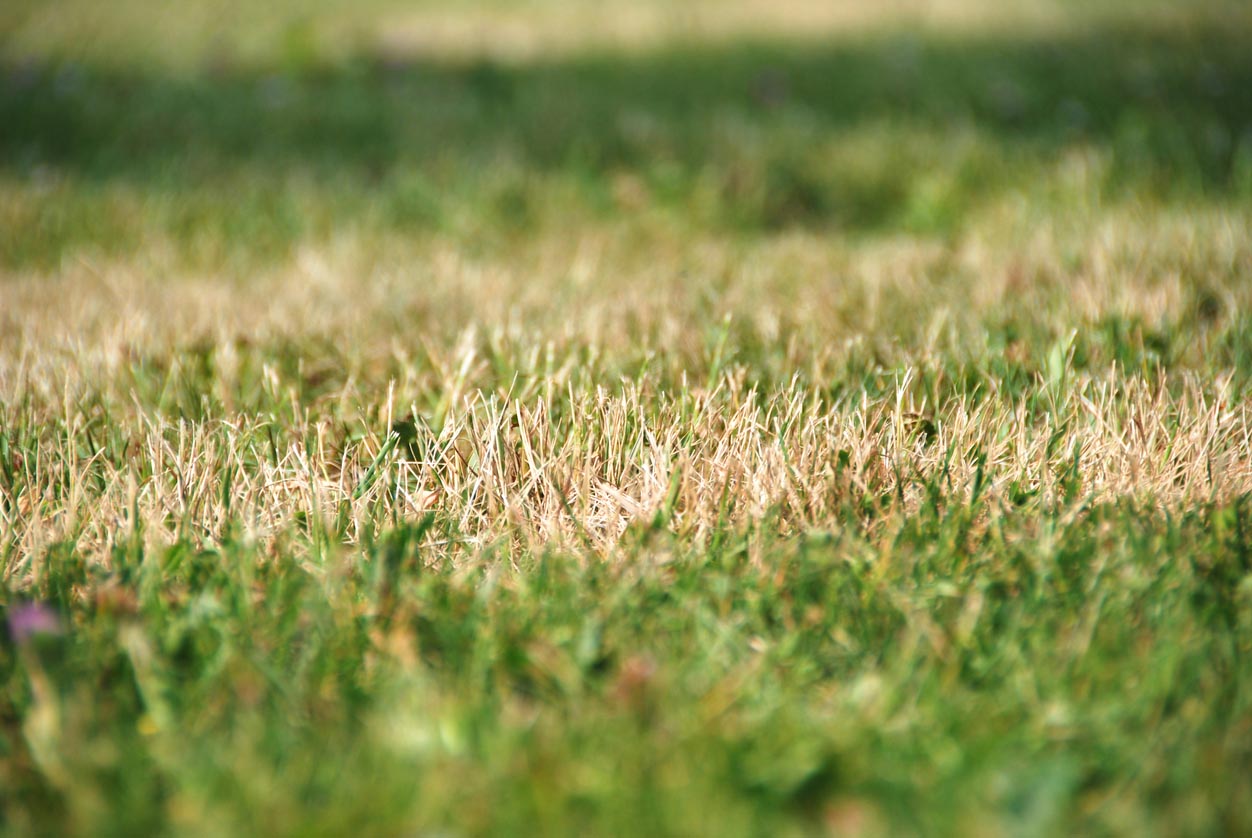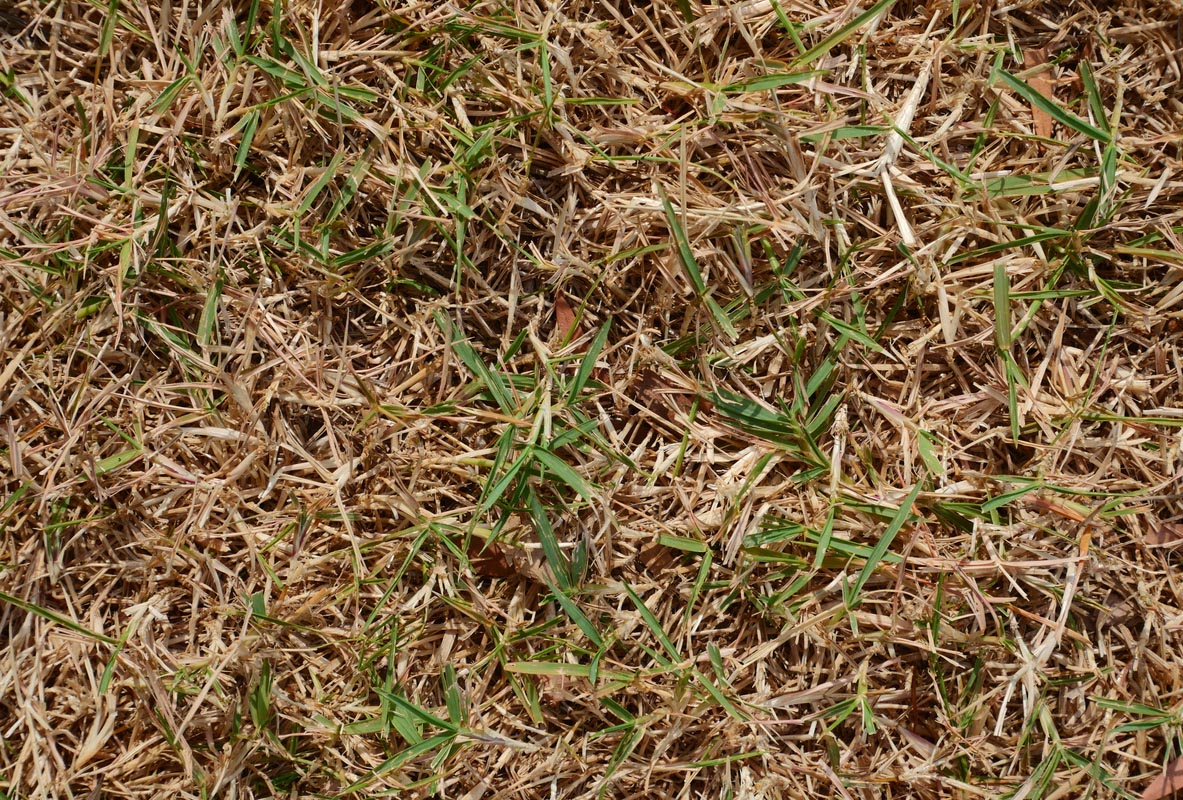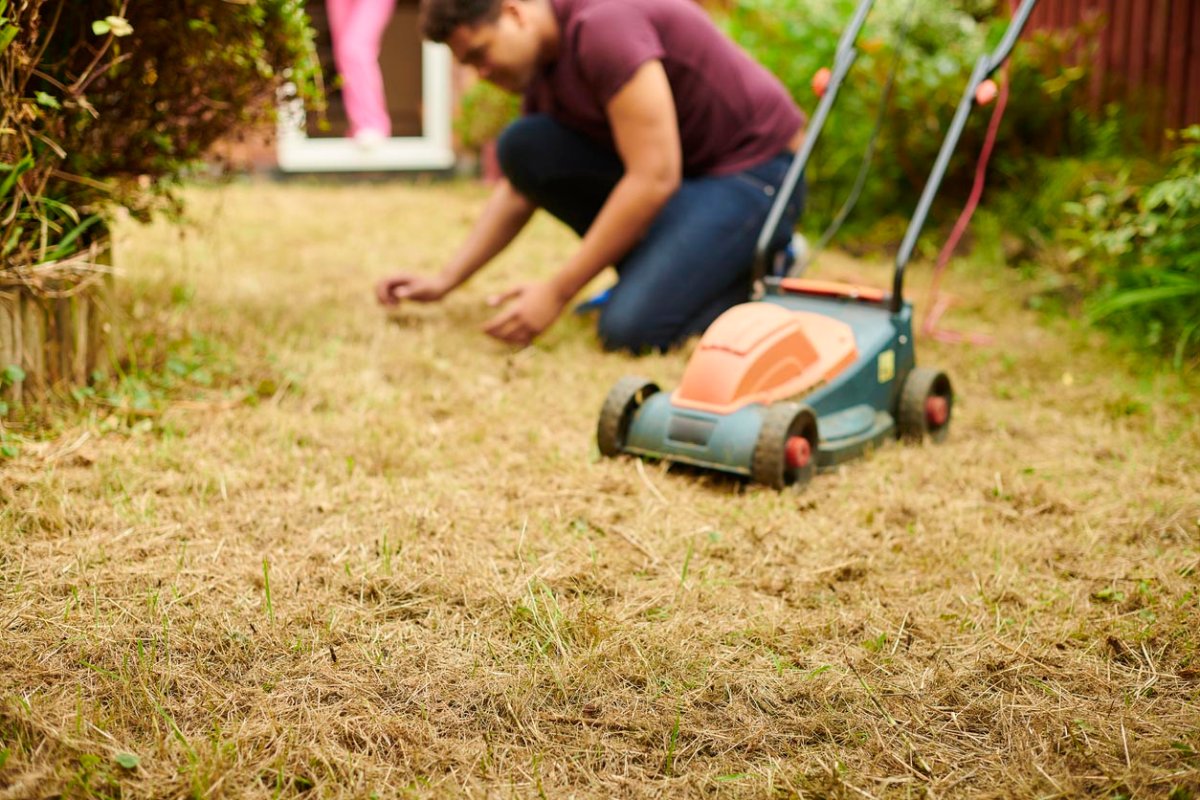We may earn revenue from the products available on this page and participate in affiliate programs. Learn More ›
Q: It’s been unusually hot in my area this summer, and I think the heat might be killing my lawn! The grass has stopped growing and is turning a brownish-gray color. Help! What can I do for my heat-stressed lawn?
A: This is a valid concern and one that many homeowners have during the dog days of summer. A browning or patchy lawn can be an eyesore that drastically reduces a home’s curb appeal. Homeowners may become frustrated if it seems like no amount of water or fertilizer can bring the grass back from the brink. They may also begin to worry about the cost of reseeding if the grass on their lawn is beyond rescue.
But fear not; a lawn that has stopped growing or is becoming discolored is sending a message that it is suffering, but that does not necessarily mean it is dying. Frank Rossi, the chief science officer at Sunday Lawn Care (a subscription service that specializes in customized, eco-friendly lawn care products) weighs in by explaining what is actually happening when a lawn is suffering from heat stress, and how homeowners can nurture their lawns back to health.

- Want to know more about Sunday Lawn Care? Check out the Bob Vila Sunday Lawn Care review.
Different types of grass and different regions of the U.S. experience heat stress differently.

The United States typically sees higher temperatures during the summer season. Some states experience this as a period of extremely warm weather that lasts well into October, while others have just a short reprieve from the bitter cold. It stands to reason that the grass that is native to these different regions would be adapted to their respective climates. Rossi explains, “There is a northern part of the country that is cool, a southern part that is warm, and then this area in between that gets a lot of both of those. It’s too cold for the grasses that like it warm, and too warm for grasses that like it cool. You experience heat stress in those areas very differently because those areas dictate the grasses that you’re growing.” He refers to grasses in colder climates (i.e., the northeast and midwest) as “cool-season grasses” and grasses in warmer climates (i.e., the south and southwest) as “warm-season grasses.”
If your grass is not adapted to heat, it’s more likely to experience heat stress.
In cases where temperatures exceed what is normal for a particular region, grasses can suffer if they are not well adapted. “If you’re a grass that grows in a warm environment, you’re more adapted to heat stress than grass that lives a lot of its life under the snow,” says Rossi. “When you have an anomaly like really warm conditions, the grasses that are adapted to that condition from the beginning do better, and the grasses that aren’t are doing worse.” Homeowners can clearly see these effects on their cool-season lawns as the summer progresses; growth slows down (or stops altogether), and the grass becomes discolored and brittle.
Even in hot climates, homeowners may believe that their warm-season grass is dying from heat, but most warm-season grasses are fairly resilient to extreme temperatures. This doesn’t mean that warm-season grasses are not also suffering, though. In many parts of the country, such as the west and southwest, drought has accompanied warmer temperatures. While warm-season grasses are good at standing up to heat, like all living things, they cannot do without water. This is different from heat stress, but the effects are similar: “You’ll see them start to look gray—a greenish, bluish, or brownish gray,” says Rossi.

Once grass starts turning brown or wilting, or growth is slowing, it’s important to hold off on mowing, nutrient, and pesticide application.
Most homeowners can tell just by looking at their lawn if it is suffering, whether from heat stress or otherwise. It can be patchy, turn yellow or brown, or stop growing altogether. At this stage, homeowners may assume that the grass is dead. But actually, this can be a sign of the grass protecting itself from further damage. Rossi explains, “Grasses have to rely on energy that they store in their root system. By this time of year…they start to enter various stages of dormancy. They have to survive and save energy until they can release buds and start to sprout again. At this point even if you give them water and fertilizer, they can’t do much with it.” Rossi says that at this stage, grass has essentially discontinued any unnecessary function and is focused solely on survival.
His advice? “The first rule is, like a doctor, do no harm: stop doing everything.” While it might seem like an unconventional lawn care tip, the key to how to fix a stressed lawn is giving the grass a chance to recover. Homeowners can do this by refraining from mowing and from applying nutrients and pesticides. If possible, it’s also a good idea to keep foot traffic to a minimum. When it seems as if the lawn is dying, it’s tempting to do something drastic like having it aerated (the cost of aeration is relatively affordable, so it’s worth doing during the growing season) or applying lots of treatments. But the grass will likely bounce back once the hottest part of the season is over, so be patient and give the lawn a chance to rest until conditions improve. At the very least, homeowners will save on the cost of lawn care during this period.

Water or irrigation is key, when permitted.
The one task that homeowners can continue to do for their grass when it reaches a dormant stage is provide it with water whenever possible. This will keep it alive for the time being while also maintaining the health of the soil. An important caveat to this is to make sure that any water or irrigation is in compliance with state drought restrictions. When water is scarce, it’s up to individuals to be conscientious about water usage to ensure that there is enough to go around. Rossi notes, “If you have an emerald-green lawn in a drought-stricken area, you are overwatering. That is bad optics.”
Overwatering is not good for a lawn either, so it’s useful to research exactly how much water is needed to keep the lawn healthy and stick to a routine. Rossi recommends Sunday’s sprinkler gauges, which measure how much water the lawn is getting, making it easy to know when to turn the sprinklers off. It’s advised to check current state regulations to find out when and how much watering is permitted.

Evaluate the quality of your soil: the soil may be the cause of the grass’s poor health—not heat.
Many homeowners tend to overlook soil health as a cause of less-than-healthy grass. Soil tends to be out of sight underneath plants and grass, and it’s not always clear what poor soil even looks like. But it’s worth distinguishing between poor-quality soil and lawn heat stress. After all, heat will diminish as the seasons change, but poor soil will remain until it is treated.
According to Rossi, there are a few visual indications of unhealthy soil to look for, “It might be rocky, not a lot of dark organic matter in it, and it doesn’t hold water. What we’ve found at Sunday to be one of the major problems facing lawns are physical problems, like rocky soil, not so much [a lack of] nutrients.” This problem has a relatively easy fix: Add organic matter, or compost. Rossi specifies, “The thing to do is put a few inches [of compost] over the top of the bad soil. If you want, you can till it into the existing soil an inch or two. You really only need about 3 or 4 inches to get the yard going.” Many communities have compost-sharing programs, so it’s not always necessary for homeowners to buy or make their own. Composting is one of the best things homeowners can do for their lawn— not only does it introduce lots of nutrients, but it does so by utilizing waste that would otherwise go into a landfill.
The key to preventing a heat-stressed lawn is early action.
As Rossi mentions, introducing fertilizer or nutrients to a lawn that is already dormant is typically considered by professionals to be a waste of time and products. Instead, the best course of action is to get ahead of the problem before extreme heat hits. “You gotta do something now for next year,” he says. “For both grass types, the best thing to do is set yourself up now for growth toward the end of the season so that in the spring you have some growth there. You want a couple of months of growth before it gets cold. Now is a critical time.” This could mean introducing fertilizers now that will sustain the lawn through the winter. Otherwise, it may mean planting a new lawn at the end of the summer while there is still time for it to take root before frosts come. Then as spring comes around, take steps to prepare the lawn for the coming heat before it’s too late.
It may take some trial and error to determine how to protect a lawn from the effects of heat stress. Grass is a living organism, so there are many variables that can contribute to its overall health. It might require some experimentation with DIY techniques and the help of some of the best lawn care services and products. Rossi advises, “Products are a very small part of what makes a lawn successful. You learn a little bit, you work smarter, and you use products that set up your plants for tough times. Having a smart lawn in these conditions might mean not always having the greenest lawn on the block.”



